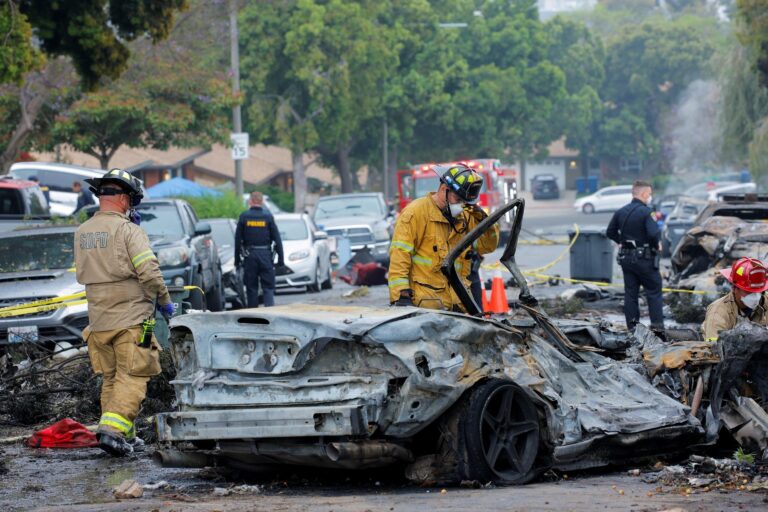A small plane carrying six people crashed off the coast of San Diego, prompting a swift response from local authorities and rescue teams. The incident, which occurred earlier today, has raised concerns as emergency crews work to locate and assist those on board. Details about the cause of the crash and the condition of the passengers are still emerging. This article provides the latest updates on the search and rescue efforts, as well as official statements from the involved agencies.
Small Plane Crash Off San Diego Coast Prompts Immediate Search and Rescue Response
The incident unfolded late Tuesday afternoon when a small aircraft, carrying six passengers, reportedly lost contact shortly after taking off near the San Diego coastline. Rescue units, including the Coast Guard and local emergency response teams, were immediately dispatched to the crash vicinity. Current conditions have complicated search efforts, with choppy waters and rapidly diminishing daylight challenging responders.
Authorities have confirmed the following actions are underway:
- Deployment of multiple search boats and helicopters equipped with infrared technology.
- Coordination with local hospitals and emergency medical services to prepare for potential survivors.
- Establishment of a command center at San Diego Harbor to manage rescue operations and communications.
| Response Unit | Assets Dispatched | Status |
|---|---|---|
| Coast Guard Sector San Diego | 2 cutters, 3 rescue boats, 2 helicopters | Active search |
| Local Fire Department | Ambulances, dive team | On standby |
| Marine Patrol | Patrol vessels | Assisting search |
Investigating Causes of Small Aircraft Accidents in Coastal Regions
Coastal regions present unique challenges for small aircraft, often combining unpredictable weather patterns, salt-laden air, and complex terrain that can complicate navigation and aircraft performance. This recent incident off the San Diego coast highlights how factors such as sudden fog banks, strong crosswinds, and limited emergency landing options can contribute to accidents. Preliminary reports suggest that despite favorable weather conditions earlier in the day, localized microclimates near the coast may have played a role in reducing visibility and affecting pilot judgment during the flight’s final approach.
Investigators are focusing on several potential causes, including mechanical failures exacerbated by corrosive saltwater exposure and pilot experience in coastal flying conditions. The following table summarizes common risk factors identified in coastal small-plane accidents:
| Risk Factor | Description | Impact |
|---|---|---|
| Microclimate Changes | Sudden weather shifts caused by sea and land temperature differences | Reduced visibility and turbulence |
| Saltwater Corrosion | Accelerated wear on aircraft components | Mechanical failures |
| Limited Emergency Options | Scarcity of suitable landing sites along rugged coastlines | Increased risk during emergencies |
| Pilot Experience | Familiarity with coastal navigation and weather patterns | Critical for safe operation |
Safety Measures and Pilot Training Enhancements for Small Plane Operations
In response to the tragic incident off the San Diego coast, aviation authorities and local flight schools are intensifying efforts to reinforce safety protocols for small aircraft operations. Enhanced pilot training now emphasizes critical emergency response skills, including water landing procedures and advanced navigation techniques. Regular simulator sessions designed to mimic adverse conditions are being introduced, helping pilots build confidence and quick decision-making abilities under pressure. Additionally, stricter pre-flight inspections and mandatory briefings for passengers on emergency protocols are becoming standard practice.
Key enhancements in pilot training and safety measures include:
- Improved in-flight communication drills with air traffic control and rescue units
- Focused scenarios on engine failure and system malfunctions during flight
- Integration of real-time weather tracking technology during pilot briefings
- Mandatory refresher courses every six months for commercial small plane operators
| Training Aspect | Enhancement | Frequency |
|---|---|---|
| Emergency Water Landing | Simulated immersive drills | Quarterly |
| Adverse Weather Navigation | Real-time weather integration | Monthly |
| Communication Protocols | Enhanced ATC coordination exercises | Bi-monthly |
| System Malfunction Response | Scenario-based training | Bi-annual |
Community Support and Resources for Families Affected by Aviation Disasters
Families impacted by aviation tragedies often face profound emotional and logistical challenges during such difficult times. Numerous organizations offer immediate and ongoing assistance, ranging from crisis counseling to help navigating legal and insurance matters. Local support groups in the San Diego area have mobilized quickly, providing a network where loved ones can share experiences and find comfort among those who truly understand the unique grief tied to aviation incidents.
Key resources available include:
- 24/7 Helplines: Dedicated lines staffed by trained crisis responders.
- Peer Support Groups: Facilitated meetings both in-person and online for family members.
- Legal and Financial Guidance: Pro bono consultations to address claims and liabilities.
- Memorial Services Coordination: Assistance organizing remembrance events.
| Resource | Contact Info | Services Offered |
|---|---|---|
| Aviation Family Assistance Network | 1-800-AVI-FAM | Counseling, peer support |
| San Diego Grief Support | sdgriefsupport.org | Local support groups, memorial planning |
| Legal Aid for Aviation Victims | 1-888-LEGAL-AV | Free legal consultations |
Closing Remarks
The investigation into the cause of the crash is ongoing, with authorities continuing to gather evidence and interview witnesses. Rescue teams have confirmed that all six individuals on board were accounted for, and medical personnel are providing care as needed. This incident serves as a reminder of the inherent risks of aviation and the importance of stringent safety measures. Further updates will be provided as more information becomes available.







